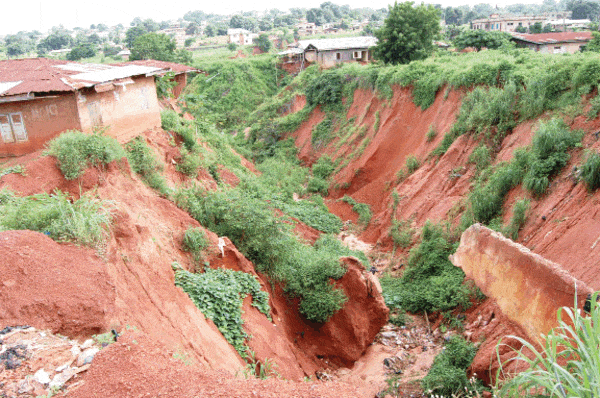By Akanimo Sampson
The people of Ubahu village, a Nanka community in Orumba North local governnent area of Anambra State in Eastern Nigeria, the hotbed of Biafra agitation, are no longer at ease as a major landslide has ruptured the social and economic peace of the area.
This disaster of nature is seriously threatening their homes and farmlands. As a result, scores of families are already fleeing their homes in search of relatively save shelters. The area has always been vulnerable to erosion menace, leading to seasonal displacement of endangered families.
Nanka comprises seven villages: Agbiligba, Enugwu, Ifite, Amako, Umudala, Ubahu, and Eti, in that order. Agbiligba is the head village in Nanka with three major kindreds (ebe n’ato); Oka, Umuduno and Umudim.
Ogbonnaya Igwe and Chuku Okoro Una in a research project in the area published last May pointed out that slopes in Nanka frequently fail during short or long, intense rainfalls mostly at the beginning of rainy season.
According to them, “he effects of high pore water pressures created by rainfalls during the rainy season and the swelling behaviour of active clay minerals in interbedded clay/shale units have been reported as the mechanism of landslides in Nanka’’, noting that majority of landslides in Hong Kong were induced by concentrated, short-duration rainfalls of high intensity.
Matric suction at shallow depths partially or completely disappears when rainfall infiltrates the soil and therefore, the slope may fail. The reduction in soil matric suction decreases the soil shear strength, and consequently causesthe slope to become unstable and fail.
One hundred and twenty landslides were documented within Nanka and its neighbouring towns of Oko and Agulu. “We have grouped them under Nanka because they are all underlain by the Nanka Formation and have similar mechanism of occurrence.
“Complex gully erosions have devastated Nanka area; the most spectacular is the Nanka-Oko gully erosion, which has destroyed several homes and farmlands. Most of the landslides in Nanka occur along the gully channels.
“The slope angles created by these gullies vary from 36o – 65o, with average slope angle of 48o. The characteristics of the soils, the nature of the slopes, and rainfall combine to produce slides that vary in scale and structure. Most of the landslides in Nanka are shallow translational debris slides, slumps and occasional debris topples
“Landslide depths in this area ranges from 0.2–1.8 m, with average depth of 0.74 m. Okagbue (1992) stated that topples (rotational falling) occasionally occur in the area. The impermeable clay beds separating the lower sand horizon acts as gliding plane for several large slumps. Many of the slumps are known to occur within the near homogeneous soil overburden’’, the researchers said, pointing out that the triggered slides in Nanka are mainly shallow with short run-out distance (< 200 m). The average landslide run-out distance in this area is 13.8 m.
In the mean time, multiple eruptions was said to have damaged farmlands, homes, major
access roads and economic trees. Residents of the area scampered for safety as the community habours many gully erosion sites.
While the late Francis Eze family, said to have a home near the Obeagu gully erosion had fled their home, including other families, an indigene of the area and an environmental activist, Ikenna Ezenekwe, says the fear of further landslides remained a constant reminder to the villagers.
“During the Peter Obi administration, in the rainy season of 2008, Governor Peter Obi paid a visit to Obeagu gully erosion following a previous landslide which swept the home of Madam Bridget Eze. Governor Obi made the pledge to assist the people of Ubahu village to ameliorate the fast growing gully erosion.
“The governor promised to construct gutter channels to control the storm flow. The
gutters have yet to be constructed. In 2010, the gully became more aggressive as a result of increased unregulated storm flow. Within the short period of 2009 to 2019, Obeagu
gully erosion doubled its original size.
“In their efforts to ameliorate the growing disaster, the village leaders took up self-action. They started by providing land for some of the families that lost their lands. They embarked on opening another access road to Umudala village and to install new electric power lines,’’ he said.

